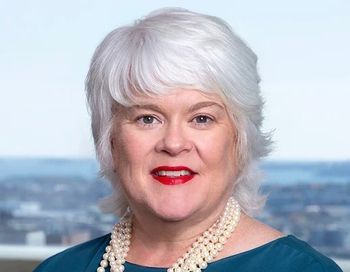
Hospitals face more pressure for transparency in prices, and lower prices
President Trump has issued an executive order calling for health systems to make it easier for consumers to compare prices. Some also want to address wide variances in prices.
Employers and patient advocacy groups have been pushing hospitals to make it easier for patients to understand their prices and shop around.
With President Trump back in the White House, hospitals and health systems may be facing more pressure on price transparency.
Trump issued
Hospitals say they have worked hard to comply with those federal regulations. Some critics, including those representing employers and patients, say hospitals aren’t doing enough.
Elizabeth Mitchell, president and CEO of Purchaser Business Group on Health, wants hospitals to make it easier to compare prices, and she wants Washington to hold hospitals more accountable. The group represents large businesses buying healthcare services for more than 21 million Americans and their families.
“If hospitals or health plans or others prevent employers from having the information that they are also legally entitled to, then it makes their job of making healthcare affordable harder,” Mitchell tells Chief Healthcare Executive®. “Remember, they're purchasing healthcare on behalf of their workforce and their families.”
Other industry analysts say most hospitals are complying with the federal rules. But they also acknowledge that it’s not easy for consumers to easily check to see if a procedure is less expensive at one hospital compared to another in their region.
But some are also saying there needs to be more attention on the wide differences in hospital prices for different procedures. Even comparing the same procedures among hospitals in the same cities, the costs can vary by several thousand dollars.
Hospitals also may be looking at the prospect of greater enforcement for violations of federal transparency regulations.
To date, the federal government has only levied only a relative handful of fines on hospitals for falling short of regulations. But hospitals worry that the Trump administration and lawmakers in Congress are going to seek more fines if hospitals aren’t meeting the requirements. And there appears to be bipartisan in price transparency for hospitals and health plans.
‘They’ve had plenty of time’
For large employers, the price transparency regulations are among their top priorities in Washington, Mitchell says. Employers are restless for progress on this front, she says.
“There's no excuse for taking four or five years to comply with a rule,” Mitchell says. “Other people don't get that window to decide if and when they're ready to comply.
“They've had plenty of time to do it, and we understand that it's burdensome and expensive,” Mitchell adds. “But you know, our current healthcare system is burdensome and expensive to its users.”
Hospitals and healthcare organizations are required to publish 300 shoppable services and procedures in a display that can be easily read by consumers or with a price estimator tool.
Different analysts have varying estimates for compliance.
PatientRightsAdvocate.org
Conversely, Chris O’Dell, senior vice president of market solutions at Turquoise Health, says most hospitals are complying with the federal rules. O’Dell tells Chief Healthcare Executive that 95% of hospitals are complying with federal law by having a machine-readable file with prices. O’Dell says some hospitals may not have perfectly readable files, and some could be missing information in a given field.
Still, O’Dell tells Chief Healthcare Executive, “The data is so much better than it ever was.”
“You're going to find holes in the file,” he says. “And it certainly doesn't do what the government intended, which is make it so someone knows what they're going to pay for a service.”
Even with hospitals making strides, O’Dell says it’s nowhere near as easy as going on a website to compare prices for flights or hotel rooms.
He acknowledges that healthcare offers different levels of complexity. Even with the same surgery, two patients may require different medications or units of blood. One patient could need an additional recovery day in the hospital. A patient’s age or underlying health conditions could have different impacts on the cost of a hospital stay.
While it’s not easy for consumers to easily compare hospital prices, O’Dell says progress is coming.
“Even though we're not quite there, we are putting in place the building blocks that will eventually get us there,” he says. “There are now innovative marketplaces …. Hospitals, pharmaceutical companies, even governments that are using this data to make it so you can shop for health care. And so it's not being used pervasively, but we're seeing the first examples of those types of innovative applications coming into the market now.”
Disparities in pricing
Hal Andrews, president & CEO of Trilliant Health, says that the narrative that hospitals aren’t meeting the requirements of the federal transparency regulations is “sort of overblown.”
“I think most hospitals are complying,” Andrews tells Chief Healthcare Executive®.
Andrews says the bigger challenge is addressing the wide discrepancy in prices among hospitals in the same market. In the New York City market, similar heart and vascular surgical procedures vary in prices by well over $100,000, according to a
“New York, by the government's definition, is the most competitive market in the country, and it has the widest price range, which doesn't make any sense,” Andrews says.
While Andrews supports efforts to improve transparency in prices for hospitals and health plans, he notes some elements don’t make it into the discussion.
First, about half of the people that are admitted to hospitals come in through the emergency department, Andrews says. “Nobody looks at their price transparency app on the way to the emergency department,” he says. “That's just not what we do.”
Even in situations where patients have more choice of a hospital, such as deciding where to have a baby, other factors are at play.
“In theory, the moms pick based upon which hospital has the best OB unit,” Andrews says. “The reality is the mom's going to go where the OB has admitting privileges.”
Employers are more likely to drive improvements in transparency in pricing, he says. Andrews expects transparency tools being developed to help craft their benefits plans, rather than websites aimed at consumers.
“I think the real value of price transparency is going to be employers focused on benefit design,” Andrews says. “And I think that's coming.”
Employers are definitely anxious for greater insights in pricing, Mitchell says. And she argues that could help reduce the wide disparities in prices for the same services in the same market.
“it's really just time for the healthcare industry to catch up with every other industry,” Mitchell says.
Concerns over penalties
The Centers for Medicare & Medicaid Services determine compliance with federal transparency regulations. In 2022, the CMS found 70% of hospitals met the federal standards, up from 27% in 2021, according to
The CMS will issue monetary penalties for hospitals that aren’t complying with the transparency rules, but the agency hasn’t been too tough on hospitals to date. With more than 6,000 hospitals nationwide, the government has issued a total of 25 fines over the past three years, according to
Typically, hospitals receive a warning from CMS about where they are falling short in meeting the federal rules for price transparency, and the agency will give guidance to hospitals to comply, says Ariel Levin, director of coverage policy at the American Hospital Association.
“I think we have seen a vast increase in compliance over the course of this role over the last four and a half years,” Levin says.
Hospitals are worried about the prospect of the government looking to impose more fines, or possibly considering bigger penalties.
Some members of Congress have expressed interest in imposing bigger fines, says Megan Cundari, senior director of federal relations at the American Hospital Association.
“I think we're also concerned about some of the civil monetary penalties getting really large,” Cundari says. “We think that there's already a lot of discretion for CMS to increase penalties as they need to. So having Congress come in and set additional high levels of penalties, we're not sure that that will do anything to get to their goal, which is to have more more disclosure.”
O’Dell of Turquoise Health says he expects to see more frequent fines and bigger penalties.
He points to language in Trump’s executive order on enforcement, where the president directs federal agencies to “issue guidance or proposed regulatory action updating enforcement policies designed to ensure compliance.”
“I think you're going to see more penalties …. he's saying, ‘People have been skating by and not doing this in the way we intended. We're going to start enforcing,’” O’Dell says.
Republicans and Democrats in Congress are also expressing more interest in price transparency, he adds.
“Both parties see an incredibly complex system where the patient is often the exhaust of it, and they say, ‘Let's fix that.’ It's nice that both parties want to get this stuff done,” O’Dell says.

















































